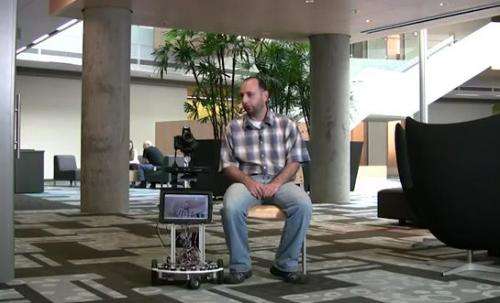(PhysOrg.com) -- News made developer rounds last month of Microsoft's Eddie, the reference robot grounded in Microsoft’s Robotics Developer Studio 4 Beta. Described as a freely available .NET-based programming environment for building robotics applications, RDS 4 allows programmers to control robotic platforms from within Windows. Microsoft now has dressed Eddie up and presented the robot as the autonomous party photographer who roams around taking pictures of people.
The demo shows how Eddie can be programmed to be a hardworking Roborazzi, supported by a Kinect-based platform and DSLR (digital single-lens reflex camera).
Features of the Eddie platform include five distance sensors, three infrared and two ultrasonic; a control board that handles operations to drive motors and collect sensor data, USB connectivity between laptop and control board, and 12 V, 14.4Ah gel-cell batteries for four to seven hours of operation.
Greg Shirakyan, a developer with Microsoft's robotics team, hosted the roving-photographer demo. He said the purpose was to show the world what a great robotic app can look like. "This is a party photographer, a fully autonomous robot that finds people in the room and takes their picture." The robot photographer has an array of infrared sensors, is powered by Windows 7, runs RDS 4, and has full support for Kinect.
The robot uses the sensors and Kinect to detect obstacles and find people. The robot was built in about three days and the algorithm is simple: Eddie detects someone in the scene, zeroes in on the person and shoots when the person is dead-center. Shirakyan said the photographer demo robot, once taking the pictures, would upload them to Flickr. Anybody who has access to RDS 4, Kinect and reference platform can develop applications similar to this robot.
Stathis Papaefstathiou, general manager for Microsoft Robotics, places Eddie the Photographer in the context of his ultimate goal, to see robots delivered to a broader audience than ever before. Eddie, short for Expandable Development Discs for Innovation and Experimentation, provides a template for developers, sharing a standardized platform from which virtually everyone can build a robot.
Designers have the opportunity to test ideas in the RDS simulator and tweak as needed before publishing an application to run on an actual robot.
“We want people to start thinking about ways to solve the constraints that prevent the consumer robot platforms. We think we are getting very close to an inflection point, where robotics will become more relevant to consumers,” said Stathis.
“We’ve defined a hardware reference platform with Kinect,” he said. “When you take RDS and use Eddie, everything just works. Here all you do is add your laptop, and it works. It’s seamless."
More information: Microsoft blog
© 2011 PhysOrg.com























